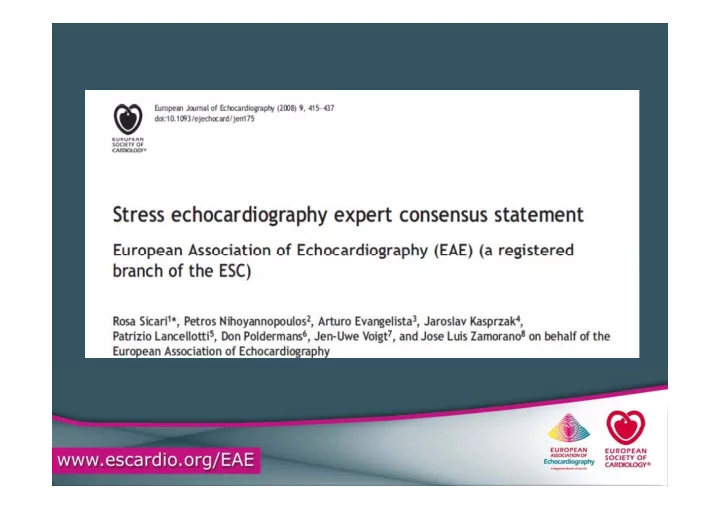

European Journal of Echocardiography. 2008 Jul;9(4):415-37
European Journal of Echocardiography. 2008 Jul;9(4):415-37
European Journal of Echocardiography. 2008 Jul;9(4):415-37
Stress Echocardiography in 4 equations = NORMAL + Rest Stress = ISCHEMIA + Stress Rest + = VIABILITY Rest Stress + = NECROSIS NECROSIS Rest Stress European Journal of Echocardiography. 2008 Jul;9(4):415-37
Stress Protocols: Dipyridamole for Dual Imaging Drugs infusion DIP 0.84 mg/kg in 6’ AMINO 120 mg in 1’ (up to 240 mg in 2’) TIMELINE 0 6 min 10 CFR-PW Continuous C ti 2D echo monitoring and Pulsed recording on the echo-monitor 1 lead ECG Continuous monitoring and 12 lead ECG Pulsed recording BP recording European Journal of Echocardiography. 2008 Jul;9(4):415-37
Stress Protocols: Dobutamine European Journal of Echocardiography. 2008 Jul;9(4):415-37
European Journal of Echocardiography. 2008 Jul;9(4):415-37
European Journal of Echocardiography. 2008 Jul;9(4):415-37
Indications for Stress Echo 1 – Coronary artery disease 2 – Prognosis and risk stratification in patients with established diagnosis 3 – Preoperative risk assessment 4 – Evaluation of cardiac etiology of exertional dypnea 4 E l ti f di ti l f ti l d 5 – Evaluation after revascularization 6 - Ischemia location 7 – Evaluation of heart valve stenosis severity 7 – Evaluation of heart valve stenosis severity
Indications for Stress Echo Key point: Stress echocardiography should not be used as a first-line imaging technique for diagnostic and prognostic purposes in patients with known or suspected coronary artery disease but only when exercise ECG stress test is p y y y either non-diagnostic or non-interpretable (e.g. for left bundle branch block or g p ( g pacemaker). The less informative and/or interpretable exercise electrocardiography the higher is the level of appropriateness to stress echocardiography.
Stress Echo Risk Titration of a Positive Test European Journal of Echocardiography. 2008 Jul;9(4):415-37
Stress Echo Risk Titration of a Negative Test Stress Echo Risk Titration of a Negative Test European Journal of Echocardiography. 2008 Jul;9(4):415-37
European Journal of Echocardiography. 2008 Jul;9(4):415-37
Stress Echo:The Safety Rules Stress Echo:The Safety Rules • Avoid contraindications A id t i di ti • Never exceed standard dosages • After signed informed consent • Always physician attending y p y g • Outpatients kept for 60’ after testing • Indications must be class I • Ex whenever possible, Dip first p , p choice for pharmacological testing
Stress Echo in Special Subsets Aortic Stenosis Key point: In the presence of LV dysfunction and y p p y low-gradient aortic stenosis, low-dose dobutamine stress echocardiography is recommended to assess stenosis severity In asymptomatic patients with severe severity. In asymptomatic patients with severe aortic stenosis, exercise echo may play a role in decision-making. European Journal of Echocardiography. 2008 Jul;9(4):415-37 Key point: Stress echocardiography is recommended in high-risk patients with a previous history of CAD scheduled Non-Cardiac Surgery for elective high-risk surgical procedures. The test is not recommended in low-to-medium-risk patients. p Key point: Stress echocardiography is recommended in patients with chest pain admitted to the ER for risk stratification patients with chest pain admitted to the ER for risk stratification Emergency Department Emergency Department purposes—especially when ECG stress test is submaximal, not feasible, or non-diagnostic.
Stress Echo vs. Competing Techniques Key point: Stress echocardiography should be preferred due to it lower cost, wider availability and—most importantly— for the radiation-free nature. Stress scintigraphy f S offers similar information to stress echocardiography, but with a radiation burden between 600 b t ith di ti b d b t 600 and 1300 chest X-rays for every single stress scintigraphy. This poses a significant biological risk both for the individual and for biological risk both for the individual and for the society, since small individual risks multiplied by millions stress tests per year become a by millions stress tests per year become a European Journal of Echocardiography. 2008 Jul;9(4):415-37 significant population burden. “When similar information is obtained with ionizing and non- ionizing techniques, the latter should be employed”
New technologies for stress Key point: “No new technology application to stress echocardiography is routinely recommended except for contrast for endocardial border enhancement, which t t f d di l b d h t hi h should be used whenever there are suboptimal resting or peak stress images Intravenous contrast for LV or peak stress images. Intravenous contrast for LV opacification improves endocardial border definition and may salvage an otherwise suboptimal study. ” European Journal of Echocardiography. 2008 Jul;9(4):415-37
European Journal of Echocardiography. 2008 Jul;9(4):415-37
European Journal of Echocardiography. 2008 Jul;9(4):415-37
Recommend
More recommend